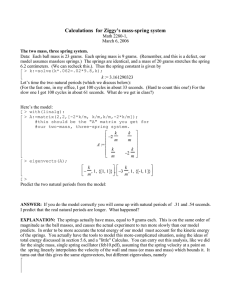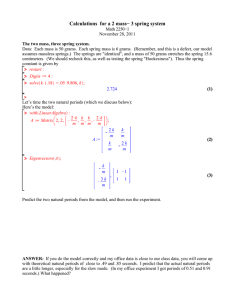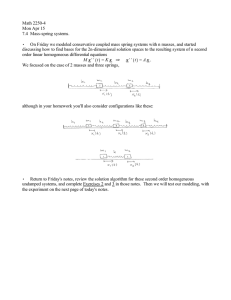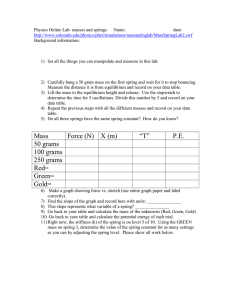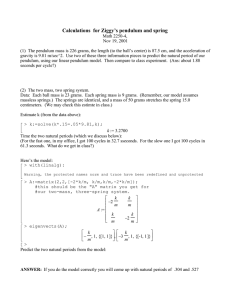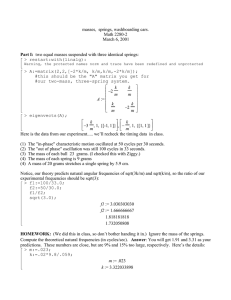Calculations for a 2 mass- 3 spring system
advertisement
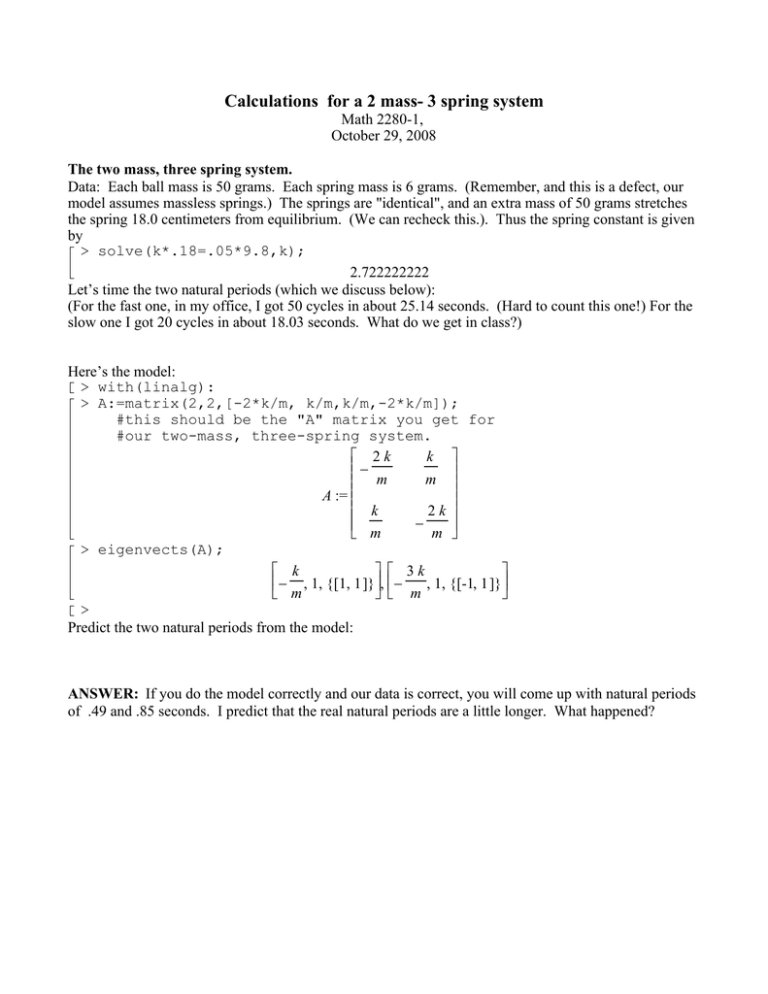
Calculations for a 2 mass- 3 spring system
Math 2280-1,
October 29, 2008
The two mass, three spring system.
Data: Each ball mass is 50 grams. Each spring mass is 6 grams. (Remember, and this is a defect, our
model assumes massless springs.) The springs are "identical", and an extra mass of 50 grams stretches
the spring 18.0 centimeters from equilibrium. (We can recheck this.). Thus the spring constant is given
by
> solve(k*.18=.05*9.8,k);
2.722222222
Let’s time the two natural periods (which we discuss below):
(For the fast one, in my office, I got 50 cycles in about 25.14 seconds. (Hard to count this one!) For the
slow one I got 20 cycles in about 18.03 seconds. What do we get in class?)
Here’s the model:
> with(linalg):
> A:=matrix(2,2,[-2*k/m, k/m,k/m,-2*k/m]);
#this should be the "A" matrix you get for
#our two-mass, three-spring system.
2k
k
−
m
m
A :=
k
2
k
−
m
m
> eigenvects(A);
k
3k
− , 1, {[1, 1 ]}, −
, 1, {[-1, 1 ]}
m
m
>
Predict the two natural periods from the model:
ANSWER: If you do the model correctly and our data is correct, you will come up with natural periods
of .49 and .85 seconds. I predict that the real natural periods are a little longer. What happened?
EXPLANATION: The springs actually have mass, equal to 6 grams each. This is almost on the same
order of magnitude as the ball masses, and causes the actual experiment to run more slowly than our
model predicts. In order to be more accurate the total energy of our model must account for the kinetic
energy of the springs. You actually have the tools to model this more-complicated situation, using the
ideas of total energy discussed in section 5.6, and a "little" Calculus. You can carry out this analysis,
like I sketched for the single mass, single spring oscillator (sept30.pdf), assuming that the spring velocity
at a point on the spring linearly interpolates the velocity of the wall and mass (or mass and mass) which
bounds it. It turns out that this gives an A-matrix the same eigenvectors, but different eigenvalues,
namely
k
λ1 = −
m + ms
9k
λ2 = −
ms + 3 m
(Hints: the "M" matrix is not diagonal, the "K" matrix is the same, and you can ignore PE from gravity
in the "total energy" formulation, because gravity just resets the equilibrium positions and doesn’t effect
the vibrations).
If you use these values, then you get period predictions
> m:=.05:
ms:=.006;
k:=2.722;
Omega1:=sqrt(k/(m+ms));
Omega2:=sqrt(9*k/(ms+3*m));
T1:=evalf(2*Pi/Omega1);
T2:=evalf(2*Pi/Omega2);
ms := 0.006
k := 2.722
Ω1 := 6.971882304
Ω2 := 12.53149878
T1 := 0.9012179260
T2 := 0.5013913672
>
of .90 and .50 seconds per cycle. Is that closer?
Challenge: If you can construct (and explain to me in my office, along with a written explanation)
a correct derivation of the eigenvalues /eigenvectors I claim above, by taking the spring masses
into account, then you can either substitute your derivation for the section 5.3 Maple exploration
in this week’s homework, or get 10 bonus points on the next midterm. This is a challenging
challenge, but it’s definitely doable.
